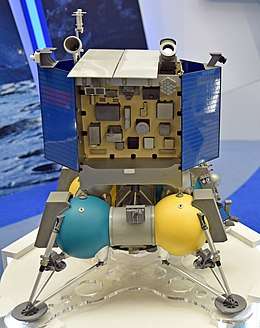Luna 27
Luna 27 (Luna-Resurs lander)[4] is a planned lunar lander mission by the Russian Federal Space Agency (Roscosmos) with collaboration by the European Space Agency (ESA) to send a lander to the South Pole–Aitken basin, an area on the far side of the Moon.[5][6][7] Its objective will be to detect and characterise lunar polar volatiles. The mission is a continuation of the Luna-Glob programme.[5]
 | |
| Names | Luna-Resurs |
|---|---|
| Mission type | Technology, reconnaissance |
| Operator | Roscosmos |
| Start of mission | |
| Launch date | August 2025 (planned)[1][2] |
| Rocket | Soyuz[3] |
| Moon lander | |
Mission
The purpose is to prospect for minerals, volatiles (nitrogen, water, carbon dioxide, ammonia, hydrogen, methane and sulfur dioxide.), and lunar water ice in permanently shadowed areas of the Moon and investigate the potential use of these natural lunar resources.[5] On the long term, Russia considers building a crewed base on the Moon's far side that would bring scientific and commercial benefits.[5]
Europe's participation in the mission received final approval at a meeting of ministers in December 2016. ESA will contribute with the development of a new type of automated landing system,[8] and will also be providing the 'PROSPECT' package, consisting of a drill (ProSEED), sample handling, and an analysis package (ProSPA).[9][10][11] The percussion drill is designed to go down to 2 m (6 ft 7 in) and collect cemented ice samples for an onboard miniaturised laboratory called ProSPA.[5][9] The scientific payload consists of fifteen instruments.[12]
The lander mission was announced in November 2014 by Russia,[13] and its launch is planned for August 2025.[1][2]
Science payload
The lander will feature 15 science instruments that will analyse the regolith, plasma in the exosphere, dust, and seismic activity.[14] The payload will include a sampling drill.[15] The notional instrument payload includes:
- ADRON-LR, active neutron and gamma-ray analysis of regolith
- Gas Analytic Package, chromatographic and mass spectroscopy of volatiles' composition
- ARIES-L, measurement of plasma in the exosphere
- LASMA-LR, laser mass-spectrometer
- LIS-TV-RPM, infrared spectrometry of minerals and imaging
- LINA, measurement of plasma and neutrals
- PmL, measurement of dust and micro-meteorites
- Radio beacon, high-power radio communication
- RAT, radio measurements of the thermal properties of the regolith
- SEISMO-LR, seismometer
- Spectrometer, UV and optical imaging of mineral composition
- THERMO-L, measurement of the thermal properties of regolith
- STS-L, panoramic and local imaging
- Laser retroreflector, Moon libration and ranging experiments
- BUNI, power and science data support
See also
- Lunar water
- Russian lunar manned spacecraft
References
- "Интервью Владимира Колмыкова" [Interview with Vladimir Kolmykov]. Roscosmos (in Russian). 14 April 2020. Retrieved 14 April 2020.
- "Рогозин сообщил о переносе запусков станций "Луна-26" и "Луна-27"" [Rogozin announces the postponement of launches of the Luna-26 and Luna-27 stations]. RIA Novosti (in Russian). 11 April 2019. Retrieved 17 September 2019.
- Mitrofanov, Igor. "Luna-Glob” and “Luna-Resurs”: science goals, payload and status (PDF). EGU General Assembly 2014.
- Missions to the Moon Luna-27. The Planetary Society.
- Ghosh, Pallab (16 October 2015). "Europe and Russia mission to assess Moon settlement". BBC News. Retrieved 2015-10-16.
- "ESA's plans for Lunar Exploration" (PDF). European Space Agency (ESA). 2014. Retrieved 2015-10-18.
- "Russia-ESA Lunar Exploration Cooperation: Luna Mission Speed Dating". European Space Agency (ESA). 17 February 2014. Retrieved 2015-10-18.
- Low-cost clocks for landing on the Moon. 26 October 2017. ESA.
- "PROSPECTing the Moon" (PDF). European Space Agency (ESA). 18 May 2015. Archived from the original (PDF) on 28 September 2015. Retrieved 2015-10-16.
- About PROSPECT. ESA. Accessed on 4 September 2019.
- "ProSPA: Analysis of Lunar Polar Volatiles and ISRU Demonstration on the Moon" (PDF).
- Luna-27 (Luna-Resurs-Lander) payload. Russian Space Research Institute (IKI). 2017.
- "Luna-Resurs lander (Luna-27)". Russian Space Web. October 10, 2014. Retrieved 2015-10-16.
- Luna 27 (Luna-Resurs-Lander) payload. Russian Space Research Institute. 2017. Accessed February 17, 2018.
- "LUNAR DRILL | Astronika". www.astronika.pl (in Polish). Retrieved 2018-11-24.
External links
![]()
